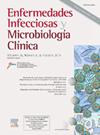Central line-associated bloodstream infections (CLABSI) in pediatric and neonatal intensive care units—The VINCat program 2013–2022
IF 2.6
4区 医学
Q3 INFECTIOUS DISEASES
Enfermedades infecciosas y microbiologia clinica
Pub Date : 2025-01-13
DOI:10.1016/j.eimc.2024.09.005
引用次数: 0
Abstract
Introduction
Central line-associated bloodstream infections (CLABSI) are among the most common and preventable hospital-acquired infections in pediatric and neonatal intensive care units (PICU–NICU). CLABSI is a common etiology of late-onset sepsis and is associated with high morbidity and mortality. The aim of this study was to describe the incidence of CLABSI in PICUs and NICUs in our geographical setting.
Methods
Descriptive study conducted as part of the VINCat program, investigating the incidence of CLABSI in NICUs and PICUs at acute care hospitals in Catalonia from 2013 to 2022. The annual CLABSI incidence rate was calculated by multiplying the total detected cases in a year by 1000 and dividing by the total patient-days with central venous catheter (CVC).
Results
NICU: The overall incidence rate was 5.59 per 1000 patient-days. Peripherally inserted CVC was involved in 59.8% of catheter-related infection, and an overall median duration of 7 days from catheter insertion to the onset of infection. PICU: The overall incidence rate was 3.62 per 1000 patient-days. Jugular venous access (44.1%) was the most common location of infections, with a median of 12 days to CLABSI. Gram-positive bacteria, especially coagulase-negative Staphylococci, were the most prevalent in both units.
Conclusions
A standardized surveillance system based on the calculation of the incidence rate of CLABSI in PICUs and NICUs can broaden our understanding of this HAI and will guide the implementation of measures of infection control and prevention.
中心静脉相关血流感染(CLABSI)在儿科和新生儿重症监护病房- VINCat计划2013-2022
中心静脉相关血流感染(CLABSI)是儿科和新生儿重症监护病房(PICU-NICU)最常见和可预防的医院获得性感染之一。CLABSI是迟发性脓毒症的常见病因,与高发病率和死亡率相关。本研究的目的是描述我国地理环境下picu和nicu中CLABSI的发生率。方法:作为VINCat项目的一部分,进行描述性研究,调查2013年至2022年加泰罗尼亚急性护理医院nicu和picu中CLABSI的发生率。CLABSI年发病率的计算方法是将一年内检测到的总病例数乘以1000,再除以中心静脉导管(CVC)总患者日数。结果icu总发病率为5.59 / 1000患者日。59.8%的导管相关感染涉及外周插入CVC,从导管插入到感染发生的总体中位持续时间为7天。PICU:总发病率为3.62 / 1000患者日。颈静脉通路(44.1%)是最常见的感染部位,到CLABSI的中位时间为12天。革兰氏阳性菌,尤其是凝固酶阴性葡萄球菌,在两个单位中最为普遍。结论建立以计算picu和nicu CLABSI发生率为基础的标准化监测系统,可以拓宽我们对这种HAI的认识,指导感染控制和预防措施的实施。
本文章由计算机程序翻译,如有差异,请以英文原文为准。
求助全文
约1分钟内获得全文
求助全文
来源期刊
CiteScore
2.10
自引率
8.00%
发文量
194
审稿时长
29 days
期刊介绍:
Hoy está universalmente reconocida la renovada y creciente importancia de la patología infecciosa: aparición de nuevos agentes patógenos, de cepas resistentes, de procesos con expresión clínica hasta ahora desconocida, de cuadros de una gran complejidad. Paralelamente, la Microbiología y la Infectología Clínicas han experimentado un gran desarrollo como respuesta al reto planteado por la actual patología infecciosa. Enfermedades Infecciosas y Microbiología Clínica es la Publicación Oficial de la Sociedad Española SEIMC. Cumple con la garantía científica de esta Sociedad, la doble función de difundir trabajos de investigación, tanto clínicos como microbiológicos, referidos a la patología infecciosa, y contribuye a la formación continuada de los interesados en aquella patología mediante artículos orientados a ese fin y elaborados por autores de la mayor calificación invitados por la revista.

 求助内容:
求助内容: 应助结果提醒方式:
应助结果提醒方式:


